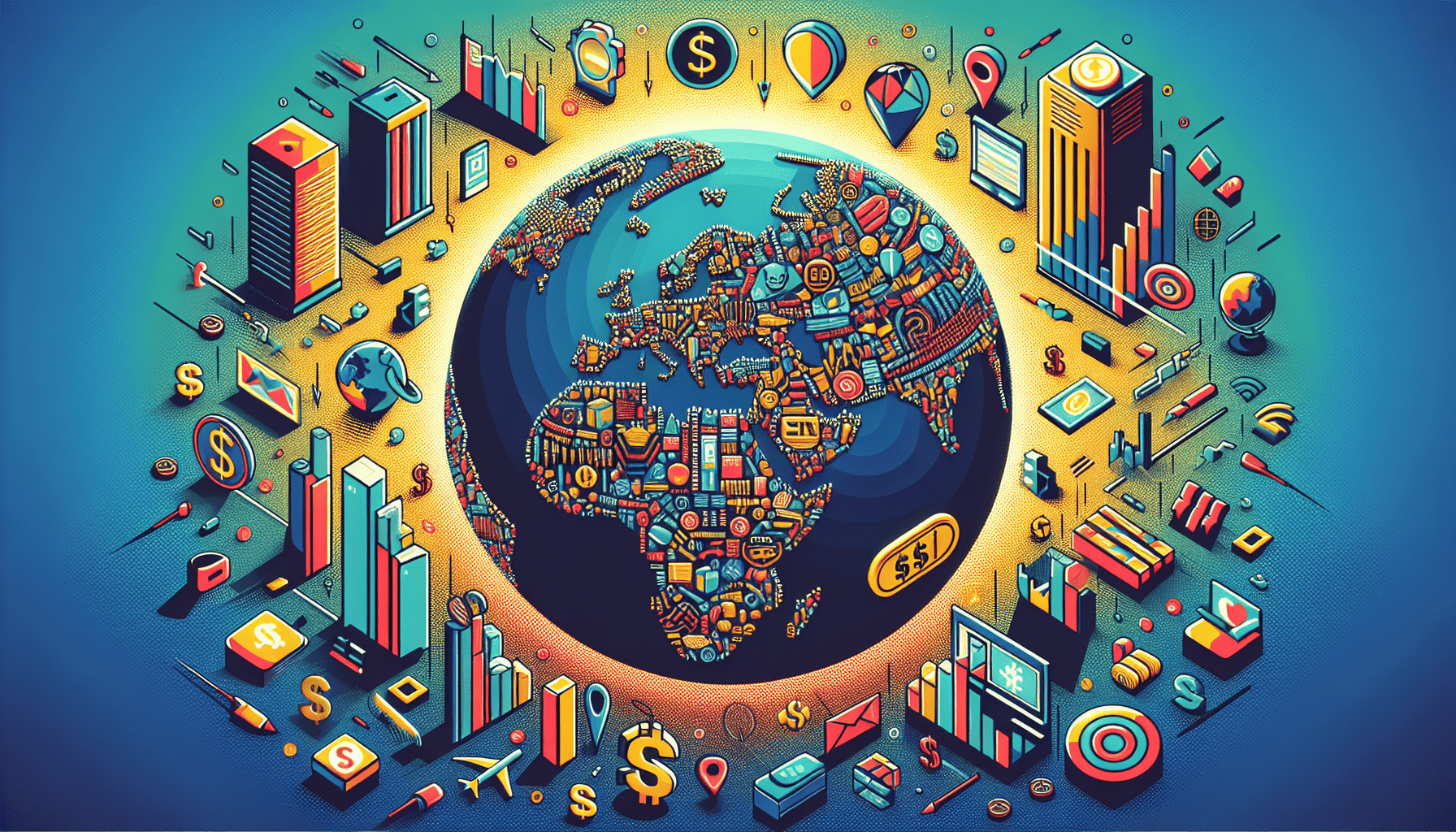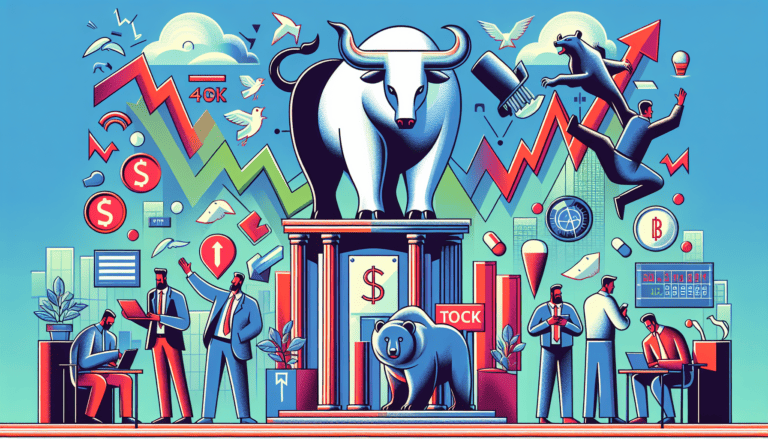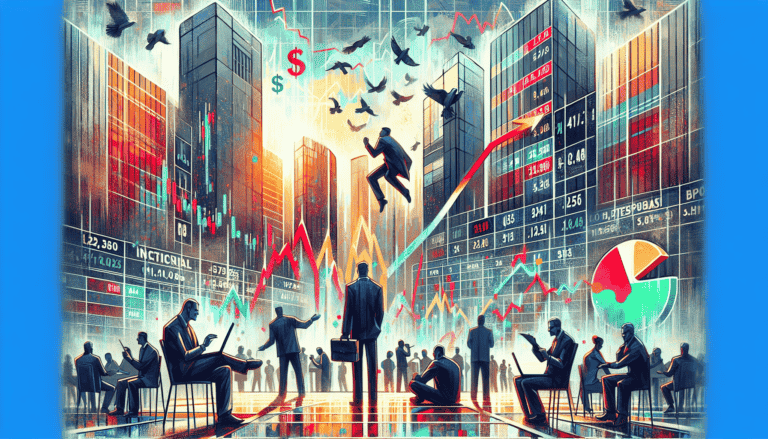Navigating the Financial Seas: Key Players in Major Global Stock Exchanges

Understanding Financial Markets
Financial markets are the backbone of the global economy, facilitating the exchange of assets and providing a platform for raising capital. Stock markets, in particular, play a vital role in this financial ecosystem.
The Role of Stock Markets
Stock markets are marketplaces where securities, such as shares of stock, bonds, and other financial instruments, are bought and sold. They serve multiple functions, including allowing companies to raise funds through initial public offerings (IPOs), providing liquidity to investors, and enabling price discovery for listed securities.
For companies, the stock market is a channel to access a vast pool of potential investors to acquire the necessary capital for expansion and growth. For investors, it presents an opportunity to gain ownership in a company, share in its profits through dividends, and potentially sell their shares at a higher price than they purchased them for, realizing a capital gain.
How Exchanges Operate
Stock exchanges operate under a set of defined rules and regulations, ensuring a fair and orderly trading environment. They can be physical locations where transactions are carried out on a trading floor, such as the New York Stock Exchange (NYSE), or electronic platforms, like the NASDAQ, where trades are executed via a network of computers (electronic trading and its impact).
Exchanges provide the infrastructure necessary for executing trades and are responsible for maintaining market efficiency. They ensure transparency by disseminating price information and trade data, which is crucial for stock market analysis techniques and investor decision-making. Moreover, exchanges are overseen by regulatory bodies to maintain investor confidence and protect against fraud.
Trades on these platforms are typically facilitated by brokers and dealers, who act as intermediaries between buyers and sellers (the role of brokers and dealers). Investors can place various types of orders, such as market orders, limit orders, and stop orders, to execute trades based on specific conditions (the mechanics of stock trading).
Understanding how stock markets and exchanges operate is foundational knowledge for beginner investors looking to navigate the major global stock exchanges. It is the first step in a journey that includes grasping concepts like market capitalization (market capitalization and its importance), analyzing stock market trends and cycles, and exploring various investment strategies, such as sustainable and ethical stock investing.
The World’s Financial Hubs
The global financial landscape is dotted with pivotal institutions that facilitate the trading of stocks, bonds, and other securities. These financial hubs, or stock exchanges, serve as the backbone of the modern economic system, enabling companies to raise capital and investors to own a share of these enterprises.
Overview of Global Exchanges
Major global stock exchanges are central marketplaces where securities are bought and sold. These exchanges vary in size, location, and the types of companies they attract. According to Wikipedia, there are twenty-one stock exchanges across the globe that have a market capitalization exceeding US$1 trillion each, representing the upper echelon of financial marketplaces. In 2016, these elite exchanges accounted for a staggering 87% of global market capitalization, highlighting their dominance in the financial world.
The following table provides a quick glance at some of the world’s largest exchanges by market capitalization, illustrating the financial clout possessed by these entities:
| Rank | Exchange | Market Capitalization (USD) |
|---|---|---|
| 1 | New York Stock Exchange (NYSE) | Over $20 trillion |
| 2 | NASDAQ | Over $11 trillion |
| 3 | Tokyo Stock Exchange | Over $6 trillion |
| 4 | London Stock Exchange | Over $4 trillion |
| 5 | Shanghai Stock Exchange | Over $4 trillion |
Data sourced from The Balance and Wikipedia.
These financial powerhouses are more than mere trading venues; they are symbols of economic strength and centers of commerce that have significant sway over the global economy. With comprehensive information on understanding stock exchanges, investors can better navigate these complex and influential institutions.
Market Capitalization Significance
Market capitalization, commonly referred to as market cap, is a critical metric in the finance industry. It indicates the total value of a company’s outstanding shares of stock and, by extension, reflects the company’s size and investment desirability. Market capitalization holds particular relevance in stock exchanges as it serves as a barometer for the overall size and health of the market.
When an exchange boasts a high cumulative market capitalization across all its listed companies, it underscores the depth and liquidity of the market—key attributes that attract investors from around the world. For instance, the NYSE’s substantial market cap of over $20 trillion signifies a robust marketplace teeming with opportunities for capital growth and investment diversification.
Investors often look at market capitalization to gauge the stability and potential growth of a company. Larger market caps typically suggest a more established company with a history of performance, while smaller market caps may indicate a newer or more volatile entity with potentially higher growth (and risk). To learn more about the implications of market cap, check out our guide on market capitalization and its importance.
Understanding the significance of market capitalization is a cornerstone of investment knowledge. It helps investors determine the size and value of different companies and assess the overall scale and influence of stock exchanges where these companies are listed. This understanding is vital for anyone looking to engage with the major global stock exchanges and invest on the global stage.
Navigating Major Exchanges
Embarking on investment journeys, individuals are often introduced to the concept of stock exchanges. These critical infrastructures serve as the venues where stock buyers and sellers converge, and where the dynamics of demand and supply manifest in stock prices. Here, we navigate through the world’s most influential stock exchanges, each playing a pivotal role in their respective economies and the global financial landscape.
NYSE: The Largest Exchange
The New York Stock Exchange (NYSE) is recognized as the largest stock exchange in the world, boasting a market capitalization surpassing $20 trillion The Balance. Situated at the heart of global finance, Wall Street, the NYSE is home to some of the planet’s most prominent companies.
| Exchange | Market Cap (USD) |
|---|---|
| NYSE | $20+ trillion |
For those keen on understanding stock exchanges, the NYSE is a quintessential model, operating with a hybrid system that blends traditional floor trading with modern electronic methods. It facilitates a vast array of transactions daily, from initial public offerings (IPOs) to the trading of established corporate stocks.
NASDAQ: The Tech Giant
Trailing closely behind is the NASDAQ stock exchange, renowned for its congregation of technology behemoths and innovative startups. With a market capitalization of over $11 trillion The Balance, NASDAQ is the second-largest exchange globally and is considered the benchmark for the technology sector.
| Exchange | Market Cap (USD) |
|---|---|
| NASDAQ | $11+ trillion |
NASDAQ’s fully electronic trading platform has been a trailblazer in electronic trading and its impact, setting the standard for modern stock exchanges around the world. Its listed companies often lead in innovation and market trends, making it a focal point for investors interested in tech-centric portfolios.
Tokyo Stock Exchange: Asia’s Leader
The Tokyo Stock Exchange stands as Asia’s premier stock exchange and ranks third in the world with a market cap of over $6 trillion The Balance. It serves as the economic barometer for the region, reflecting the health and performance of not just Japan’s, but also Asia’s corporate giants.
| Exchange | Market Cap (USD) |
|---|---|
| Tokyo Stock Exchange | $6+ trillion |
Investors looking to diversify their investments across different markets might consider the Tokyo Stock Exchange as a gateway to Asia’s dynamic economies. It is also a focal point for those monitoring stock market trends and cycles in the East.
London Stock Exchange: A Historical Powerhouse
The London Stock Exchange (LSE), one of the oldest stock exchanges, is currently the fourth-largest in the world with over $4 trillion in market capitalization The Balance. Its longstanding history and global reach make it a vital component of the world’s financial system.
| Exchange | Market Cap (USD) |
|---|---|
| London Stock Exchange | $4+ trillion |
The LSE’s enduring presence and its ability to adapt to the changing financial landscape is illustrated by its extensive offerings, from blue-chip stocks to exchange-traded funds (ETFs) in stock markets. It’s a testament to the market’s resilience and its pivotal role in global finance.
Shanghai Stock Exchange: China’s Financial Giant
Completing the top five is the Shanghai Stock Exchange, which has rapidly ascended to become the fifth-largest stock exchange with a market capitalization also over $4 trillion The Balance. It symbolizes China’s growing influence in global financial markets and its status as an economic superpower.
| Exchange | Market Cap (USD) |
|---|---|
| Shanghai Stock Exchange | $4+ trillion |
For investors considering exposure to China’s economic growth, the Shanghai Stock Exchange is an indispensable platform. It offers a unique blend of state-owned enterprises and private sector companies, reflecting the diverse nature of China’s economic landscape.
Each of these major global stock exchanges is a key player in the world of finance, presenting opportunities and considerations for beginner investors. By choosing the right exchange and employing strategies like diversification and stock market analysis techniques, one can navigate these financial seas with greater confidence and insight.
The “$1 Trillion Club”
The elite group of stock exchanges known as the “$1 Trillion Club” comprises those with market capitalizations exceeding $1 trillion. These financial juggernauts dominate the global landscape, setting the stage for international investment and economic trends.
Characteristics of Top Exchanges
The characteristics of the top exchanges in the “$1 Trillion Club” are diverse yet share commonalities in their ability to influence global finance. Here are some of the key features:
- Market Dominance: As of 2016, the combined exchanges within this club accounted for 87% of global market capitalization, demonstrating their dominance and the concentration of financial power.
- Vast Investor Base: These exchanges attract a vast array of investors from around the world, including institutional, retail, and government entities.
- Diverse Listing Options: They offer a range of products including equities, bonds, ETFs, derivatives, and more, catering to various investor needs.
- Innovation and Technology: Adopting cutting-edge technology for trading platforms and electronic trading to enhance market accessibility and efficiency (electronic trading and its impact).
- Stringent Regulation: Top exchanges are typically subject to rigorous oversight to ensure fair trading practices and investor protection.
| Exchange | Market Capitalization (USD trillion) |
|---|---|
| NYSE | Over 20 |
| NASDAQ | Over 11 |
| Tokyo Stock Exchange | Over 6 |
| London Stock Exchange | Over 4 |
| Shanghai Stock Exchange | Over 4 |
Data Source: The Balance
Global Influence and Operations
The influence of these exchanges extends far beyond their home countries, impacting global markets and economies:
- Cross-Listings and International Investments: They facilitate cross-listings, allowing companies to access capital from investors worldwide and enabling investors to diversify their portfolios internationally (diversification across markets).
- Benchmark for Global Market Sentiment: These exchanges often set the tone for global market sentiment, influencing investor confidence across the world (bull and bear markets: market sentiment).
- Economic Indicators: Indices from these exchanges serve as key economic indicators, reflecting the health of industries and economies (stock market indices explained).
- Liquidity Providers: Due to the high volume of transactions, these exchanges provide liquidity that is crucial for the smooth operation of financial markets.
The “1 Trillion Club” represents the pinnacle of stock exchange operations, offering unparalleled opportunities for growth, investment, and financial innovation. For beginner investors looking to navigate these waters, understanding the characteristics and global influence of these exchanges is a pivotal step in making informed investment decisions.
Decoding Market Capitalization
Understanding the concept of market capitalization is essential for anyone interested in the financial markets and investing in major global stock exchanges. Market capitalization, often referred to as market cap, provides insight into a company’s size and its overall value in the stock market.
Calculating Market Cap
Market capitalization is calculated by multiplying the total number of a company’s outstanding shares by its current stock price. This figure represents the company’s value as perceived by the stock market and reflects what investors are willing to pay for its stock. Here is the basic formula:
Market Capitalization = Total Outstanding Shares x Current Stock Price
For example, if a company has 1 million shares outstanding and the current stock price is $50, the market cap would be $50 million.
| Company | Outstanding Shares | Stock Price | Market Cap |
|---|---|---|---|
| Company A | 1,000,000 | $50 | $50,000,000 |
| Company B | 500,000 | $100 | $50,000,000 |
Both companies have the same market cap but differ in the number of shares outstanding and stock price.
Market Cap and Company Size
Market capitalization classifies companies into different size segments which are indicative of their risk and growth profiles. These segments include:
- Large-cap companies typically have market caps over $10 billion. They are generally established and stable.
- Mid-cap companies with market caps between $2 billion and $10 billion often have the potential for growth and more risk than large-cap companies.
- Small-cap companies are usually valued between $300 million to $2 billion and may offer higher growth potential, but with increased risk.
Investors utilize these classifications to assess a company’s stability, growth prospects, and the risks associated with investing in them. It is also a determining factor for the inclusion of companies in major stock market indices, such as the S&P 500 or the Dow Jones Industrial Average (Wikipedia). The market cap can significantly impact an index’s performance since companies with larger caps carry more weight.
Nevertheless, market cap should not be the sole determinant when evaluating a company’s investment potential. While it offers a snapshot of company size, other factors such as financial health, industry performance, and quality of management are crucial. Moreover, the market cap is a dynamic metric, changing daily with stock price fluctuations. Investors must consider this volatility and conduct comprehensive stock market analysis techniques to make informed decisions.
For beginner investors, understanding market capitalization is a stepping stone towards making educated investment choices on the global stage. It’s a fundamental metric that, along with other financial indicators, can guide investors in building a diversified and resilient portfolio.
Investing on the Global Stage
Investing in the global marketplace offers a multitude of opportunities for growth, diversification, and exposure to different economic sectors. Understanding the landscape of major global stock exchanges is a foundational step for beginner investors venturing into international investments.
Choosing the Right Exchange
Selecting the right stock exchange is a critical decision for any investor. Each exchange has its specialties and characteristics that can align with different investment strategies and goals.
- New York Stock Exchange (NYSE): Known as one of the largest stock exchanges in the world, the NYSE offers a broad array of investment opportunities across various industries, including blue-chip companies that are considered to be stable and financially sound (The Balance).
- NASDAQ: This exchange is recognized for its concentration in technology firms and provides investors with the chance to partake in innovative and rapidly growing sectors (The Balance).
- Tokyo Stock Exchange: As a key player in Asia, this exchange allows for investment in a wide range of Japanese industries, from cutting-edge technology to traditional automotive and financial companies (The Balance).
- London Stock Exchange (LSE): With its long history, the LSE offers access to a vast array of international firms and is noted for its strengths in sectors such as finance, energy, and mining.
- Shanghai Stock Exchange: This major Chinese market is an avenue for investment across diverse sectors including technology, manufacturing, and financial services (The Balance).
For beginner investors, it’s important to assess each exchange based on factors like market stability, types of available investments, regulation and oversight, and economic conditions. Moreover, investors should consider their own risk tolerance, investment timeline, and whether they wish to invest directly or through vehicles such as exchange-traded funds (ETFs).
Diversification Across Markets
Diversification is a key strategy to manage risk and maximize potential returns. By spreading investments across various stock exchanges, investors can benefit from the growth in different economies and sectors while mitigating the impact of a downturn in any single market.
Investing in different exchanges can be achieved through individual stocks, mutual funds, or ETFs. Each method comes with its own set of considerations regarding liquidity, costs, and tax implications. ETFs, for instance, can provide instant diversification as they often hold a basket of stocks from various markets.
| Method | Description |
|---|---|
| Individual Stocks | Direct investment in specific companies across different exchanges. |
| Mutual Funds | Professionally managed funds that pool money from many investors to purchase securities. |
| ETFs | Investment funds traded on stock exchanges, much like stocks. They hold assets such as stocks, commodities, or bonds. |
Investors should also stay informed on global economic trends, currency risks, and geopolitical events which can affect international markets. Tools such as stock market analysis techniques can aid in making informed decisions.
In conclusion, choosing the right exchange and diversifying across markets are fundamental steps for investing on the global stage. By carefully selecting exchanges that align with their investment objectives and spreading their investments to minimize risk, beginner investors can navigate the financial seas and set sail towards their financial goals.





